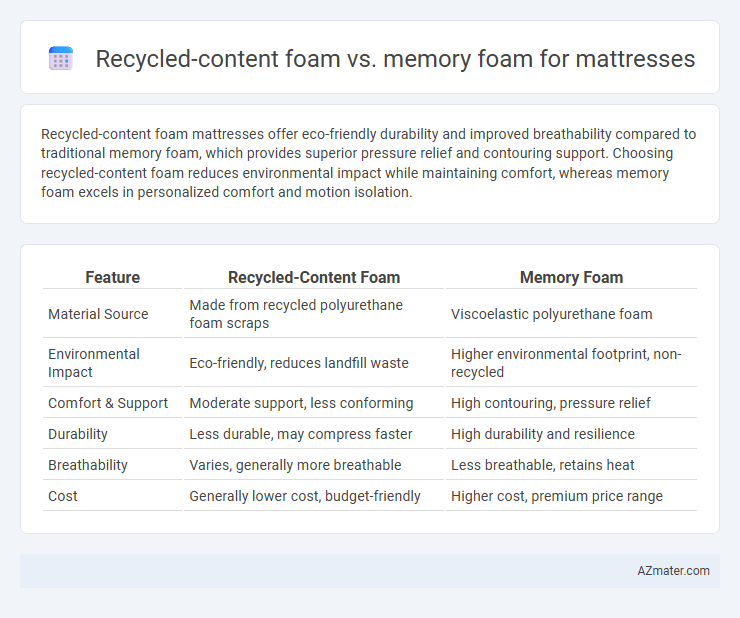Recycled-content foam mattresses offer eco-friendly durability and improved breathability compared to traditional memory foam, which provides superior pressure relief and contouring support. Choosing recycled-content foam reduces environmental impact while maintaining comfort, whereas memory foam excels in personalized comfort and motion isolation.
Table of Comparison
| Feature | Recycled-Content Foam | Memory Foam |
|---|---|---|
| Material Source | Made from recycled polyurethane foam scraps | Viscoelastic polyurethane foam |
| Environmental Impact | Eco-friendly, reduces landfill waste | Higher environmental footprint, non-recycled |
| Comfort & Support | Moderate support, less conforming | High contouring, pressure relief |
| Durability | Less durable, may compress faster | High durability and resilience |
| Breathability | Varies, generally more breathable | Less breathable, retains heat |
| Cost | Generally lower cost, budget-friendly | Higher cost, premium price range |
Introduction to Mattress Foams
Recycled-content foam mattress offers an eco-friendly option by incorporating repurposed materials that reduce environmental impact while maintaining durability and comfort. Memory foam, known for its viscoelastic properties, provides superior pressure relief and contouring by responding to body heat and weight, enhancing sleep quality. Choosing between recycled-content foam and memory foam depends on priorities like sustainability, support, and personalized comfort needs.
What is Recycled-Content Foam?
Recycled-content foam is a type of mattress material made by incorporating post-consumer or post-industrial recycled foam into the production process, reducing environmental impact and waste. It offers comparable comfort and support to traditional foams while promoting sustainability by diverting foam from landfills. This eco-friendly option appeals to environmentally conscious consumers seeking mattress solutions with reduced carbon footprints.
Understanding Memory Foam
Memory foam, a viscoelastic material originally developed by NASA, offers superior pressure relief and body contouring by responding to heat and weight, promoting spinal alignment and reducing motion transfer. Recycled-content foam combines eco-friendly materials reclaimed from discarded foams to reduce environmental impact but may vary in durability, density, and responsiveness compared to pure memory foam. Understanding memory foam's closed-cell structure and viscoelastic properties helps consumers distinguish its unique comfort and longevity benefits when compared to recycled-content alternatives.
Sustainability: Recycled-Content Foam vs Memory Foam
Recycled-content foam mattresses use materials reclaimed from manufacturing waste and post-consumer products, significantly reducing environmental impact by lowering landfill contributions and minimizing resource extraction. Memory foam, typically derived from petroleum-based polyurethanes, has a higher carbon footprint due to its production process and limited recyclability after use. Choosing recycled-content foam supports a circular economy and enhances sustainability through resource efficiency and reduced ecological footprint compared to conventional memory foam options.
Comfort and Support Comparison
Recycled-content foam mattress combines eco-friendly materials with medium-firm support, offering good pressure relief and responsiveness suitable for a variety of sleepers. Memory foam excels in contouring to body shape, providing exceptional comfort and spinal alignment, particularly beneficial for side sleepers or those with joint pain. While recycled-content foam emphasizes sustainability and durability, memory foam focuses on immersive comfort and heat retention management.
Durability and Longevity
Recycled-content foam mattresses often offer moderate durability but may degrade faster than memory foam due to lower density and varying material quality. Memory foam, especially high-density types, provides superior longevity by maintaining shape and support over years of use, resisting sagging and body impressions effectively. Choosing memory foam typically ensures better performance in terms of durability and comfort retention, contributing to a longer lifespan for the mattress.
Allergen and Chemical Considerations
Recycled-content foam mattresses typically contain fewer volatile organic compounds (VOCs) and may emit lower levels of allergens due to their manufacturing from pre-used materials, which are often processed to remove contaminants. Memory foam, while praised for its pressure relief, can off-gas higher amounts of VOCs, potentially aggravating chemical sensitivities and triggering allergic reactions in sensitive individuals. Choosing a mattress with certifications like CertiPUR-US ensures reduced chemical exposure and improved indoor air quality, benefiting allergy sufferers.
Cost Differences and Affordability
Recycled-content foam mattresses typically cost 20-30% less than memory foam mattresses due to lower manufacturing expenses and sustainable material sourcing. Memory foam offers superior pressure relief and durability but comes at a premium price, often ranging from $800 to over $2,000. For budget-conscious buyers, recycled-content foam provides an affordable alternative without sacrificing essential comfort and support.
Consumer Preferences and Trends
Consumers increasingly favor recycled-content foam mattresses due to environmental sustainability and reduced carbon footprints, aligning with growing eco-conscious trends. Memory foam remains popular for its pressure-relief, contouring abilities, and durability, especially among individuals seeking orthopedic benefits and enhanced sleep quality. Market data reveals a rising demand for hybrid models combining recycled-content foam's eco-friendly attributes with memory foam's comfort, reflecting evolving consumer preferences toward both sustainability and performance.
Which Foam is Right for You?
Recycled-content foam mattress offers an eco-friendly option with durable support and a firmer feel, making it ideal for environmentally conscious sleepers seeking budget-friendly comfort. Memory foam contours to your body, providing pressure relief and motion isolation, which suits those who prioritize personalized comfort and pain reduction. Choosing between the two depends on whether you value sustainability and resilience over adaptive support and softness.

Infographic: Recycled-content foam vs Memory foam for Mattress
 azmater.com
azmater.com